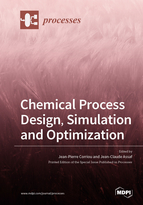Chemical Process Design, Simulation and Optimization
A special issue of Processes (ISSN 2227-9717). This special issue belongs to the section "Chemical Processes and Systems".
Deadline for manuscript submissions: closed (31 December 2020) | Viewed by 86543
Special Issue Editors
Interests: process modelling, simulation, optimization and control; chemical processes; signal processing; numerical methods
Interests: process design; process modeling; process simulation; process optimization; process control; refining processes
Special Issues, Collections and Topics in MDPI journals
Special Issue Information
Dear Colleagues,
Chemical Process Design, Simulation and Optimization constitute the core of the activity of chemical process engineers, process developers and designers, process economic evaluators, energy engineers and researchers implicated in chemical engineering.
This Special Issue explores the design and simulation of new and revamped chemical processes as well as the numerical modeling and optimization of existing plants/processes using proven software. Thus, it offers novel illustrative examples, prospective applications and solutions to improve chemical processes. The aim of this issue is to combine theoretical principles with examples modeled by commonly-used simulation software (AspenPlus, AspenHysys, Pro/II, Prosim, CHEMCAD, Scilab, Matlab and others) employing steady-state or dynamic process simulation. Furthermore, applying numerical methods and optimization at both the theoretical and practical levels are within the scope of this issue. Original research papers and reviews covering a wide range of processes such as chemical industries, refining, oil and gas and engineering processes will be considered for publication.
Topics include, but are not limited to applications in the following areas:
- Design and simulation of a novel or revamped chemical process
- Optimization of the processing capacity and operating conditions of a current chemical process
- Improvement of equipment design and the performance of a specific chemical process
- Monitoring safety and operational issues in chemical plants
- Identification of energy savings opportunities, material integration and economic evaluation to realize savings in the process design
- Development of efficient numerical and optimization methods with applications in chemical and energy engineering
Dr. Jean-Claude Assaf
Guest Editors
Manuscript Submission Information
Manuscripts should be submitted online at www.mdpi.com by registering and logging in to this website. Once you are registered, click here to go to the submission form. Manuscripts can be submitted until the deadline. All submissions that pass pre-check are peer-reviewed. Accepted papers will be published continuously in the journal (as soon as accepted) and will be listed together on the special issue website. Research articles, review articles as well as short communications are invited. For planned papers, a title and short abstract (about 100 words) can be sent to the Editorial Office for announcement on this website.
Submitted manuscripts should not have been published previously, nor be under consideration for publication elsewhere (except conference proceedings papers). All manuscripts are thoroughly refereed through a single-blind peer-review process. A guide for authors and other relevant information for submission of manuscripts is available on the Instructions for Authors page. Processes is an international peer-reviewed open access monthly journal published by MDPI.
Please visit the Instructions for Authors page before submitting a manuscript. The Article Processing Charge (APC) for publication in this open access journal is 2400 CHF (Swiss Francs). Submitted papers should be well formatted and use good English. Authors may use MDPI's English editing service prior to publication or during author revisions.
Keywords
- process modelling
- simulation
- optimization and control
- chemical processes
- linear and non-linear processes







